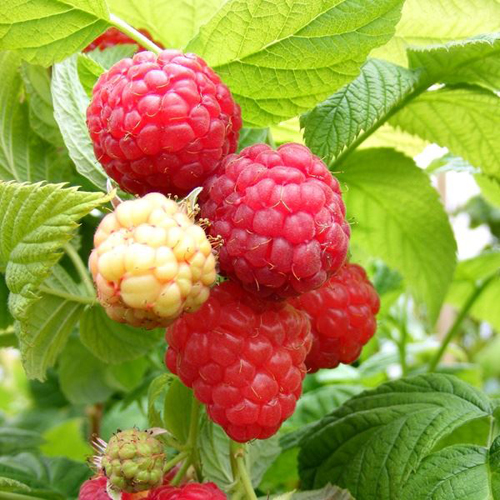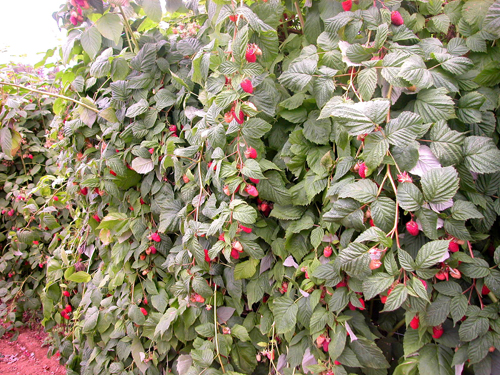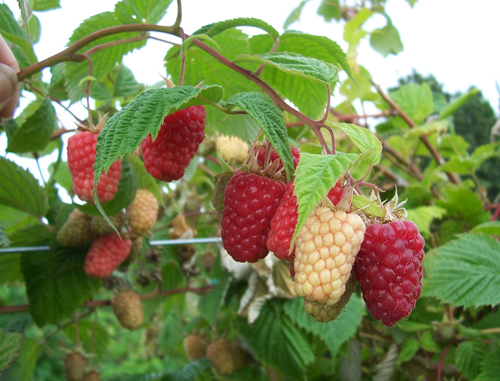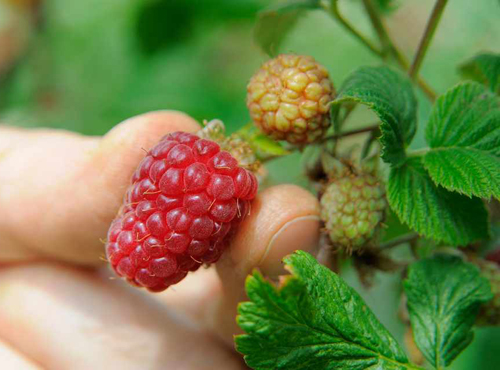Raspberry variety Cascade Delight
Cascade Delight is one of the brightest varieties of the famous "Cascade" series, bred by the American breeder - Dr. P. Moore. This raspberry came to our country relatively recently, but has already managed to settle in the plots of many gardeners. But, unfortunately, not always and not everyone is able to find the keys to it. And it's really worth it! In Cascade delight, both the yield and the size of the fruits are successfully combined, and most importantly for many - an excellent sweet taste. How to make our hero arouse real delight, his proven characteristics and features of agricultural technology - more about this in our article below.

History of creation
The cultivar is derived from a cross-crossing of Chilliwack and WSU 994 in 1989. Its pedigree also contains the genes of the famous old raspberry Meeker. The seeds obtained from hybridization were planted in a greenhouse in 1990. Based on fruiting results in 1992, seedlings designated as WSU 1090 were selected. The selection was based on large, strong, attractive fruits and a clear high yield. In 1993, test planting of seedlings obtained from root cuttings was carried out in Puyallap. They confirmed the preservation of all fruit and vegetative characteristics in the offspring.
The work was carried out with government support by a group of breeders led by Dr. Patrick Moore. The birthplace of the novelty is Puyallup Research and Extension Center (WSU Puyallup), affiliated with the University of Washington (WSU). In 2002, the variety was filed for registration, and in February 2004 it was patented as WSU 1090. Patent number USPP14522P3. Successor - Washington State University.
The second name given to the variety is Cascade Delight (2003), translated into Russian means "Cascade of Delight" or "Cascade Delight". He was the first in a line of the breeder's brainchildren of the same name: Cascade Bounty (2005), Cascade Dawn (2005), Cascade Gold (2010) and Cascade Harvest (2013).
Description
Cascade Delight is a mid-ripening American variety of summer raspberries. Fruiting on overwintered shoots last year. Moreover, good growth of the bush and an increase in yield occurs after reaching 3 years of age. In the south, raspberries begin to bear fruit from the third decade of June, in the conditions of the Middle Belt, as well as in the west and north of Ukraine - from the second decade of July. Fruiting is relatively compressed, lasts up to 1 month. When the early varieties have already given half of the harvest, our hero is just beginning to bear fruit. This makes it possible to extend the berry season, creates a continuous fruit conveyor.

The variety has good vigor, produces a lot of stems, 10-12 stems per season. The shoots are tall, strong, mostly 1.6-2.0 meters high, and with proper agricultural technology they can grow up to 2.5 meters. The shoots are of a half-stem type, but the bush itself is sloping, the internodes are rather short - this is one of the features of the Cascade Delight. The average width of the stems is 1.8-2.0 cm. Young shoots are juicy green in color, ripen by winter and acquire a brownish-gray hue. During fruiting, the shoots can change color to anthocyanin. They are covered with a light waxy coating, without pubescence and with a few spines. In this raspberry, the growth of shoots in the first year is no more than 1 meter. The plant has a strong root system, roots are thick and well branched. The thorns are small, straight, purple in color. Stems up to a height of 30 cm are densely studded, the density is 20-40 pieces per 1 linear cm. And already growing, after reaching a height of 1 meter, the density of thorns is less than 5 pieces per 1 cm of the shoot. Laterals are medium and long, elastic, strong, well branched (2-4 orders of branching). Almost studless, green, but can acquire an anthocyanin hue.
In the early years of Cascade Delight growing, many gardeners have problems with shoot growth - the bushes seem to sit still.They are stocky, stocky, with large leaves and short internodes. Often the main stem is split into several. One gets the impression that the variety is sick with something. But after several years, the bush is gaining strength, and the growth energy becomes quite high, the plant produces many long stems. It is advisable to install a trellis (1.8 meters high) or support when cultivating raspberries. Due to the numerous shoots and shortened internodes, the plantings are often thickened, and this leads to a deterioration in the phytosanitary state and complication of berry picking. Therefore, it is necessary to carry out cutting of excess shoots and regular sanitization.
The leaves are large, wide, corrugated, ovoid with a sharp nose. Consist of 5 leaves of a deep green color. They are slightly pubescent, with sharply serrated edges. The denticles can become reddish-brown in color. The largest leaves are 13 cm long and 8.6 cm wide. They are larger than the Meeker and Tulamin varieties. Often the foliage takes on a lemon-green hue or even becomes just yellow. What is characteristic, such a color is characteristic not only of young growth (nettles), but also of already fruiting plants. Often, gardeners simply cannot understand what is wrong with raspberries. It looks like chlorosis in a very strong form. Moreover, this does not affect the yield indicators.

The Cascade is blooming since the third decade of May. The flowers are collected in numerous, dense, elongated bunches. They are large, 2-2.5 cm wide, white, without a pronounced aroma. A lot of ovaries are formed. The fruits are very beautiful, uniform and even. They are wide, fleshy, elongated - conical in shape. The berries in the first harvest are very large, the average weight is 8.4 grams. A couple of weeks after the start of fruiting, the size is somewhat smaller and the average weight is already 5.6 grams. The average length of fruits in the season is 3.3 cm, width is 2.4 cm, but they can grow in length up to 5 cm.
Raspberry berries are light, bright red, with a weak glossy shine and slight pubescence. On the fruits, there is a non-intense whitish bloom. Drupes are small, homogeneous, tightly interconnected. The seeds are small, almost imperceptible when consumed. When collected, they are removed from the bush without effort, even not fully ripe, do not crumble or flow. Another feature of the variety is the heterogeneous, mosaic color of some berries. For example, dark red fruits may have lighter, orange-reddish sides.
The fruits have the highest tasting characteristics. They are sweet, but without sugary, refreshing, rich-raspberry flavor. The berries are firm, firm, but the pulp is juicy, with a thick raspberry aroma. Sugar and acid levels are perfectly balanced, and BRIX levels are high.
In July 2000, an analysis of raspberries was carried out in Puyallup, Washington, USA, the results are presented in the table.
| Variety name | PH level | Titratable acidity,% | BRIX level,% | Anthocyanins, mg / g |
| Cascade delight | 2,98 | 1,8 | 10,4 | 0,440 |
| Meeker | 3,18 | 1,05 | 11,8 | 0,468 |
| Tulameen | 3,0 | 1,48 | 11,3 | 0,406 |

Transportability and keeping quality of berries is at a high level. These indicators are just excellent when the fruit is properly cooled. Moreover, transportability is good even for fully ripe berries. The berries of our hero, due to their appearance, size and taste, are highly popular both in wholesale and retail trade. Delight cascade differs from the reference Tulamin in longer and thicker shoots, denser and larger fruits, and a greater number of drupes.
Fruits for universal use. In addition to direct commercial purposes, they are perfect for fresh consumption, freezing, drying and various types of processing. Especially wonderful jam comes out, sweet, aromatic, really raspberry flavor.In addition, the berries do not boil in it.
Raspberries are characterized by good frost resistance. But slight freezing of stems and buds is possible. It is advisable to bend down the shoots for the winter as a safety net, tying them with a pigtail. And in regions with severe winters, cover the bent shoots with agrofibre. In extreme heat, berries can be baked in direct sun. But most of the harvest is hidden under large leaves that protect the fruits from the scorching rays.
Delight cascade is resistant to a number of major diseases and crop pests. In particular, to anthracnose. Susceptible to the large raspberry aphid and the virus it carries. Namely, the raspberry dwarf virus (RBDV), which spreads among plants through pollen. And also often there is a defeat of the variety with root cancer. Prevention - high agricultural background, regular provision of moisture and planting healthy seedlings. In damp, cool weather, the fruit can be affected by gray mold. Often it is affected by stem gall midge.
Our hero has excellent yield potential. From one bush, depending on agricultural technology, the productivity is 4-7 kg. The fruiting zone is up to 70% of the shoot length. The variety is very sensitive to watering. With a lack of moisture, the berries greatly lose in size and taste.
To obtain a high yield, regular, balanced nutrition and comprehensive protection from diseases and pests are desirable. The Delight cascade responds positively to the introduction of organic matter into the soil. It will not be superfluous to plow into the ground and mulch the plantings of raspberries with mown siderates, in particular white or yellow mustard.
Comparative characteristics of varieties based on the results of studies of 6 seasons (from 1995 to 2002).
| Variety name | Cascade delight | Tulameen | Meeker | Willamette |
| Productivity, t / acre | 7,8 | 7,8 | 7,1 | 5,8 |
| Yield per bush, kg | 3,95 | 3,51 | 3,37 | 3,1 |
| Berry weight, g | 4,90 | 4,06 | 3,24 | 3,27 |
| Rotting percentage | 9,8 | 5,6 | 5,9 | 5,1 |
| Density of berries, g | 203 | 174 | 180 | 180 |
| Date of 50% collection | June, 22 | 21st of June | 21st of June | July 13 |
| Fruiting period, days | 24 | 29 | 26 | 25 |
For research, the plants were planted according to the scheme: 0.9 meters between bushes in a row, row spacing was 2.4 meters. The experiments were carried out by the WSU Puyallup Research Center. To calculate the average weight, 25 berries were randomly selected, weighed, and then the average value was displayed. Industrial yields were measured per acre. 1 acre = 0.4 hectares. Consequently, the yield per hectare is 19.5 tons. And this is with a distance between plants of 0.9 meters. If you plant after 50 cm, then the productivity indicators will be almost 2 times higher.
Strengths
- Slightly spiny stalks, laterals practically glabrous (without thorns).
- Beautiful, even and one-dimensional, dense berries.
- Large and very large fruit size. Drupes are small with medium-sized seeds, which are hardly perceptible when consumed.
- High rates of raspberry yield.
- Storage and transportability are at a high level.
- A good choice for creating a berry conveyor, in continuation of early varieties.
- Ability to develop normally on poor and clayey soils. Good adaptation to various growing conditions.
- Excellent presentation of berries. Cascade Delight is in high demand both in the retail and wholesale markets.
- Heat resistance is average, but most of the berries are hidden under the leaves that protect them.
- Excellent raspberry, sweet taste and rich, pleasant aroma.
- High growth vigor, good reproduction rate.
- The berries are easily separated from the fruit, even at the stage of technical ripeness. When collected, they do not crumble and do not flow, when ripe they practically do not crumble from the bush.
Weak sides
- High dependence of fruit size on regular watering.
- Poor resistance to root cancer and raspberry dwarf virus. Affection by aphids and stem gall midge.
- The bush is vigorous, can thicken significantly, regular pruning is required.
- Significant developmental delay at the beginning of the growing season.
- Lack of stability - the yield of the variety and the characteristics of the fruit vary greatly from site to site.
- Berries are unevenly colored. And foliage often turns yellow in the middle of the season.
- In rainy, cool weather, the taste and density of the Cascade Delight berries deteriorate, and raspberries may be damaged by gray rot.
- It is desirable to install a high (up to 2 meters) trellis or supports.
Author: Maxim Zarechny.









What kind of raspberry will turn out if you plant a cascade with seeds? Will it be renovated?